Dog fleas are a real nuisance because not only do they make Fido itch, but they can bite everyone in the house and drive the whole family crazy. Fleas on dogs can also lead to severe health problems in pets that are more than just annoying.
Unfortunately, recent statistics claim that one in seven dogs has fleas.1If they infest your home, dog fleas can be difficult to eradicate. A quick and thorough response is your best bet to relieve your dog’s discomfort, restore peace in the home, and rest assured these parasites stay clear of your pooch moving forward.
So, what’s the best way to kill dog fleas quickly? Read on to learn the best treatment and prevention for fleas on dogs — plus why you should take these parasites' health risks seriously.
Table of Contents:
- The risks associated with fleas on dogs
- Understanding the life cycle of fleas
- How to spot fleas on dogs
- Signs Your Dogs Has Fleas
- How to kill fleas on dogs
- How to get rid of fleas in the house
- How to prevent dogs from getting fleas
- Best method of flea control for dogs
- Frequently Asked Questions
Understanding the Life Cycle of Fleas
Here’s a closer look at their development to give you a better sense of why it’s so important to get rid of fleas on dogs ASAP:
- The flea life cycle has four distinct stages (egg, larva, cocoon, and adult), which can take between two weeks and a year to complete depending on environmental factors like temperature, humidity, and the presence of a feeding host.
- One adult female flea can lay as many as 2,000 eggs throughout her lifespan while sucking the blood of the host she lives on.
- Eggs can hatch in just two days and disperse throughout the house every time your dog scratches, shakes, or lies down.
- Eggs molt into flea larvae that can then crawl with consuming blood and feces from other fleas known as “flea dirt”.
- During the cacoon (AKA pupal) stage, the larvae cast cocoons called pupae where they can survive for up to a year waiting for a warm-bodied host.
- Adult fleas use their overdeveloped legs to jump onto their canine host in search of a meal and a mate, as they cannot lay eggs until they eat.
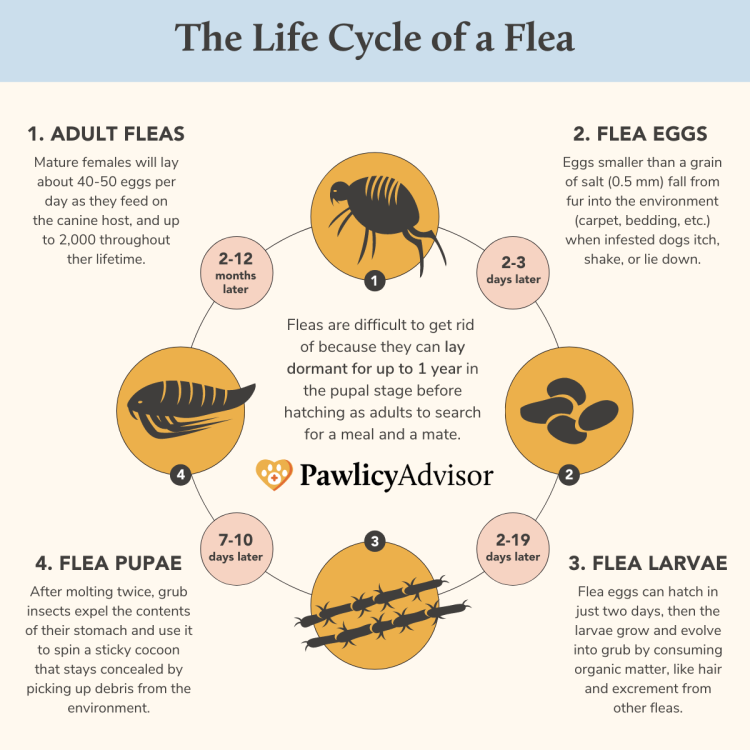
It is crucial to understand the life cycle since different flea treatments for dogs target various stages. Before using any flea-elimination medications, always read the label and follow the instructions.
Veterinarians believe that for every six fleas you see on your four-legged friend, there are 300 more fleas in your home!4! So, even if you see just one flea, be sure to take the issue seriously.
How to Spot Fleas on Dogs
If you’re wondering, “Does my dog have fleas?” or whether you’re able to see fleas on dogs, here are some clues that point toward an infestation — but remember, your veterinarian is always the best source of information and advice. You might get flea bites, as well (usually seen around the ankles).
What Fleas Look Like on Dogs
There are a few different flea species that can be found on dogs, but the dog flea (Ctenocephalides canis) and cat flea (Ctenocephalides felis) are the two most common. At maturiry, they're about the size of a pinhead and have a dark copper hue.
In the dog flea pictures below, you can see a close-up look at these microscopic parasites that are well-known to infest dogs' coats then their homes shortly thereafter.
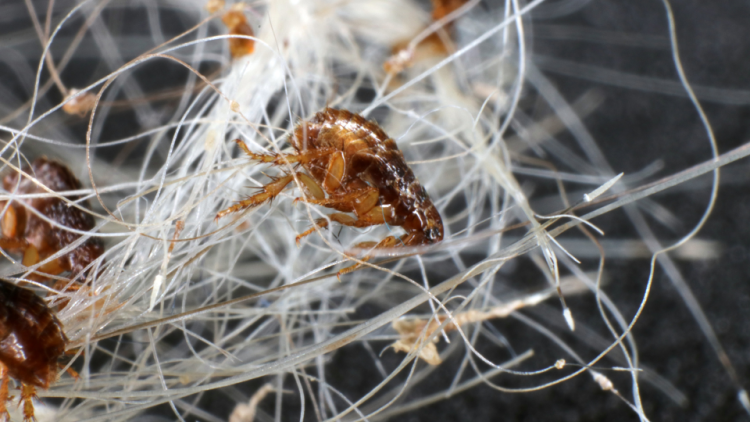
Compared to flea egg or flea larvae images, adults are much easier to discern with the naked eye. TMoreover, microscopic flea eggs are usually laid in very difficult-to-see places within crevices, along baseboards, and so forth, making them all the more challenging to detect before an infestation occurs.
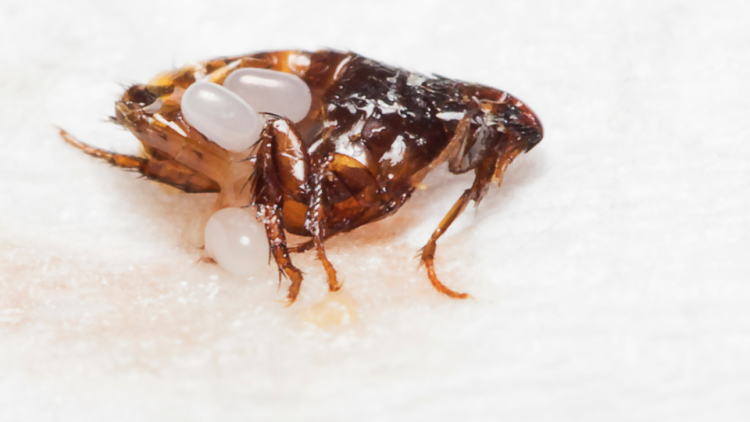
Fleas don't like light, and therefore try to hideout within dogs' skin folds and shaded areas of the coat. The best places to look for fleas on a dog are:
- Along the shoulder blades
- At the base of the tail
- Down the back of the legs
- Beneath the belly where skin is exposed
- Between the inner thighs
Use a fine-tooth flea comb to make sure you don't miss external parasites with the naked eye. When inspecting your dog’s skin and coat, a good place to start is near the rear end, where fleas to prefer to land on dogs. Peference for this spot explains why its very common to see pets gnawing at their flanks and the area above the tail.
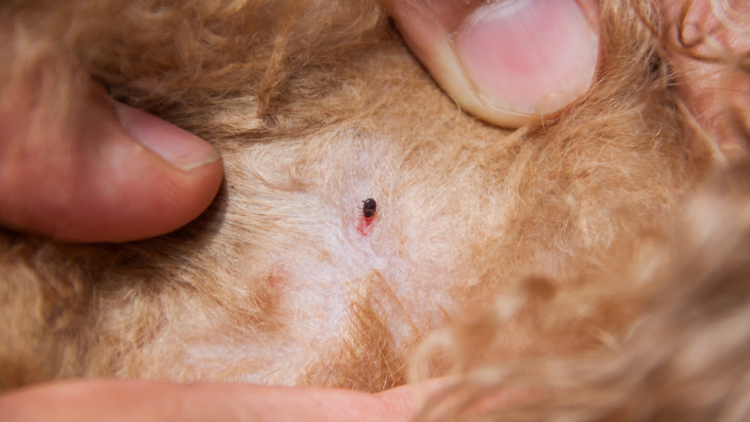
Live fleas might catch your eye as they move through dogs’ fur since they jump very high and fast. This is one way you can tell fleas apart from other types of parasites in dogs and puppies, like ticks, which are predominantly stationary. And, they’re actually visible on the canine’s outer layer of skin (unlike scabies and mites, which are not).
If you sift through your dog’s coat, you might notice tiny specs flea dirt, or dark red excrement colored by the host's freshly consumed blood, which appears black once dried. This is usually a tell-tale sign of parasites, along with frequent scratching and any bites you may have of your own, often around the ankles.
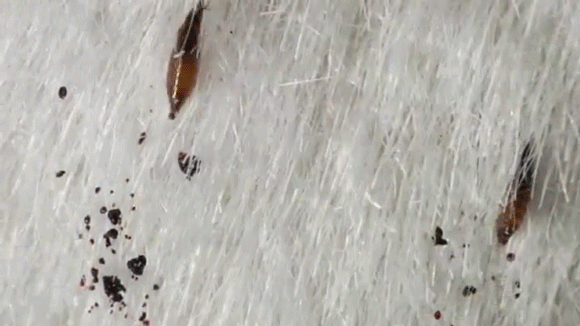
(Source: Fleas — Michael Dryden, DVM, MS, PhD)
Signs Your Dog Has Fleas
The most common signs of fleas in dogs include:
- Excessive itching (also known as pruritus)
- Gnawing at skin
- Frequent scratching at specific locations, especially the base of the tail
- Flea eggs (white specks) in the fur
- Flea dirt (dark specks) in the fur
- Hot spots, scabs, or skin irritation
- Skin edema, ulceration, and hair loss in dogs with flea allergies
While some symptoms of fleas on dogs can mirror other health issues (like allergies), if you notice any of the signs above, there’s a good chance your dog is infested. Ask your vet’s opinion and recommended treatment method given your pet’s age and medical history.
How to Kill Fleas on Dogs
There are several types of flea treatments for dogs that your vet may suggest:
- Bathe your dog with lukewarm water and mild soap. Dish soap can also help drown adult fleas. If you are thinking about using specialized flea removal products like flea shampoo, be sure to speak to your vet first, as the harsh chemicals may irritate your dog’s sensitive skin or present health hazards to young puppies. Never use products made for dogs to get rid of fleas on kittens or cats, as most formulas contain a compound highly toxic to felines.
- Use a fine-tooth flea comb to pick through your dog's hair. Repeatedly dip the comb in a solution of water and dish soap to catch the fleas and prevent them from jumping away.
- Do routine checks to see how the infestation is clearing up. If your four-legged friend has a history of fleas, use a flea comb at least once every week until you are certain that both your home and your pet are flea-free.
How to Treat Fleas on Puppies
Many puppies have fleas from breeders, but getting rid of them requires a different treatment method because the active ingredients in flea removal products are too strong to use safely until puppies reach at least seven to eight weeks old.
Your veterinarian can recommend a suitable method to treat puppy fleas according to your dog’s age . They’ll also discuss when to start giving your puppy flea preventatives as part of their preventive pet care routine.
How to Get Rid of Fleas in the House
The Environmental Protection Agency (EPA)5 recommends the following to eradicate fleas from your house:
- Vacuum all mattresses, floors, and upholstery. Fleas (along with flea eggs, larvae, and cocoons) typically hide in cracks and other small locations. If possible, use a vacuum with a bag you can throw away without touching the contents.
- Steam clean carpets and upholstery, including pet beds. Intense heat and soap are sure to kill fleas in all stages. Particular attention should be paid to any areas where your pet frequently rests or relaxes.
- Wash all bedding in hot water and detergent then dry on the highest heat setting. In cases of severe flea infestation, think about throwing out your old bedding.
How to Prevent Dogs from Getting Fleas
Preventive pet care is the best way to deal with fleas. Flea preventatives come in a variety of formats, enabling you to find the right solution that works for your lifestyle and your dog’s preferences.
- Veterinary prescription
- Oral tablets
- Topical liquids
- Flea collars
- Home insect repellent
Flea control products can be effective almost immediately. In most cases, they work by killing any new or existing flea that tries to bite your dog. However, it’s still possible for these parasites to get inside the house by jumping onto your dog and abstaining from a tasty meal, instead jumping off before puncturing skin. So, ongoing flea control may be necessary to protect the interior of your home — especially in climates known for high flea populations.
Best Method of Flea Control For Dogs
Some flea treatments only target flea eggs, flea larvae, or adult fleas, so it is important to buy the right one. Others contain ingredients that treat two or more conditions like Lyme disease and heartworm disease in dogs ticks, ear mites, and heartworm infection.
It’s crucial to know which product your pet is on so you understand what they’re protected against, what risks they’re vulnerable to, and when they need to their next dose to maintain defense (on a monthly, tri-monthly, or semi-annual basis).
Prescription Flea Medication
The best way to treat dog fleas is with a prescription from your veterinarian who knows the severity of your case, as well as your pet’s age and medical history. While over-the-counter flea treatments for dogs can be effective, they should be used with caution because an overdose may be lethal if applied in excess, while too little of a dose could be ineffective.
Oral Flea Control for Dogs
Oral flea treatments include pills and chewable tablets that your dog can take as if it were a treat (though not all pets enjoy the flavor). Capstar is a popular oral tablet that kills adult fleas. It starts to function within half an hour and kills more than 90% of all fleas within four hours.
Topical Flea Control for Dogs
Topical flea treatments include collars and ointments. The FDA suggests being very careful while selecting the proper formula and using it exactly as instructed.6 The dosage will depend on the dog’s age and weight. Flea treatments like Revolution and Frontline swiftly travel between fleas, killing adults and preventing the emergence of young ones. The majority of fleas will die within a few hours, but it may take several days for a topical treatment to take full effect.
If you’re worried about the cost of flea preventatives, pet wellness plans may help. Pet wellness plans are usually an add-on cost on top of your monthly payments for accident and illness insurance and cover a certain percentage (or provide an annual limit) for a number of preventative care benefits such as annual check-ups, routine vaccines, dental cleanings, and of course, flea, tick, and heartworm prevention.
Natural Flea Control for Dogs
Many dog parents seek non-chemical flea control methods. However, some natural flea and tick remedies such as geranium, eucalyptus, and pennyroyal essential oil can cause severe reactions in pets. Check with your veterinarian before giving your four-legged friend any type of herbal treatment.
Frequently Asked Questions
Are fleas the same for cats and dogs?
Dog fleas (Ctenocephalides canis) are not the same species as cat fleas (Ctenocephalides felis). However, despite their name, cat fleas can also infest dogs and a variety of other species in addition to people.
Can dog fleas infest the house?
Pets may leave fleas behind, which can then lay their eggs in carpets, bedding, and furniture, hatch, and spread throughout your house. How quickly dog fleas can infest a house depends on factors like humidity and temperature. In a home environment, the flea life cycle is usually completed within 17 to 26 days. Eggs hatch into larvae within two to three days.
Can my dog sleep in my bed with fleas?
If your dog sleeps in your bed and has fleas, they can hop around and bite you while you're asleep, leaving you with a lot of itchy bites the next day.
Does laundry kill fleas?
Doing your laundry can be an effective way to get rid of fleas. This effect is the result of the combined action of heat and laundry detergent as fleas are remarkably tough insects and highly unlikely to drown in the washing machine.
Do fleas die in hot water?
Yes, hot water can kill fleas! However, you should be mindful of when you use this extermination method as scalding hot water will burn your dog's skin. Killing fleas with hot water can only be done for environmental treatments.
Does shaving your dog help get rid of fleas?
No. While shaving can sometimes make it easier for dog parents to determine whether their pet has fleas or help with the effects of a flea infestation, it is not a reliable flea treatment or preventative.
How can I keep fleas off my dog naturally?
Fleas can be naturally repelled by eucalyptus, tea tree, citronella, rosemary, and peppermint. Simply mix a few drops of your preferred essential oil with 10-15 oz of water and spray the solution directly over your dog's coat. Keep in mind, however, that some essential oils, such as eucalyptus can cause severe reactions in pets.
How does baking soda get rid of fleas on dogs?
Baking soda offers no protection for your dog against fleas because it cannot kill adult fleas. It has been recommended by certain online pet sites because it might dry out flea eggs and larvae. However, there is absolutely no proof that using baking soda to kill fleas works.
Why does my dog keep getting fleas even after treatment?
Some flea treatments only kill adult fleas, so fleas can continue to appear for months after you thought an infection has stopped. A newly hatched female flea can deposit eggs as soon as one day after finding a host. The key to preventing fleas is consistent treatment and prevention.
Can fleas live in your bed?
Yes, these pests infest multiple areas in the home, especially carpeting, cushions, mattresses, bedding, pet beds, and upholstered furniture.
Is one flea a problem?
If you have spotted only one flea, it most probably attached to your pet while they were outside. One flea won't be enough to spread an infestation since fleas need both male and female counterparts to reproduce and lay eggs.
Can dog fleas live on other animals?
Fleas can live on other mammals and birds, including livestock and rodents. Fleas are drawn to these animals because of their fur or feathers.
Can dog fleas live on cats?
Yes, your dog could become infested with dog fleas or cat fleas and then pass them on to your feline friend.
What kills fleas in the yard instantly?
You can get rid of fleas in your yard by sprinkling diatomaceous earth on it.
What kills flea eggs on dogs?
There are many spot-on flea products that are approved for use on dogs, such as Frontline, Vectra, and Revolution. Used on a monthly basis, each of these products controls both flea eggs and adult fleas.
Spray your dog with an apple cider vinegar solution (apple cider vinegar diluted in water), just bear in mind that fleas cannot be killed by apple cider vinegar, but it can help to deter them.
References:
- University of Bristol, “1 in 4 cats and 1 in 7 dogs carrying fleas with high levels of bacteria, finds Big Flea Project”, Accessed on October 12, 2022
- Hills Pet, “Common Causes of Dog Skin Conditions”, Accessed on October 12, 2022
- My Pet, “Fleas and Ticks”, Accessed on October 12, 2022
- Oklahoma State University, “Flea Control”, Accessed on October 12, 2022
- EPA, “Controlling Fleas and Ticks Around Your Home”, Accessed on October 12, 2022
- FDA, “Safe Use of Flea and Tick Products in Pets”, Accessed on October 12, 2022
